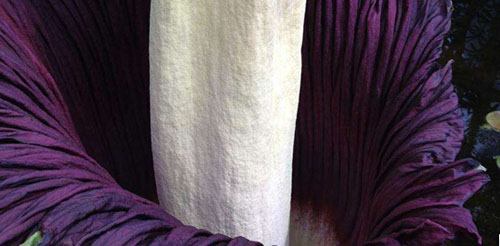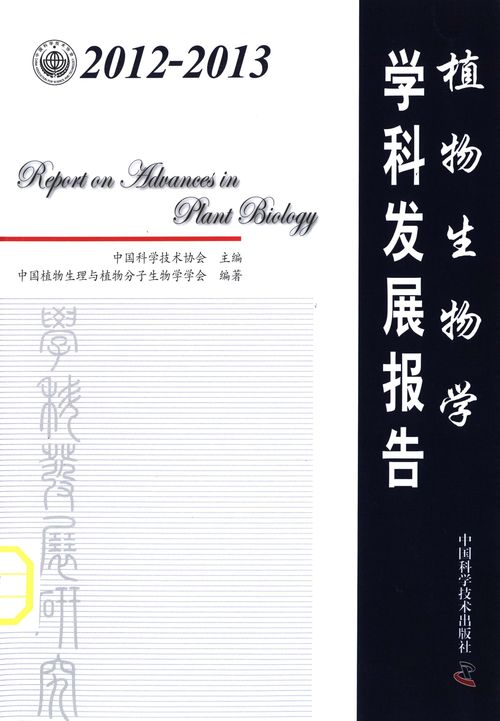
揭开世界上最臭鲜花的秘密



[导读] 泰坦魔芋属于世界濒危物种,在盛开时花朵不但没有香味,甚至还散发出类似腐尸的恶臭,这也为它赢得了“尸花”的称谓。根据科学家的研究,这种气味要归功于二甲基二硫化物(DMDS)和二甲基三硫醚(DMTS)。
中国科技网7月10日报道(张微 编译)这是一次“愉快的巧合”,在远离家乡西苏门答腊岛的德文郡佩恩顿动物园和爱丁堡皇家植物园,泰坦魔芋花这个世界上最臭的花,竟然同时绽放了。这是一个罕见的情况,而相应的,在纽约,康奈尔大学的泰坦魔芋花也一直在大出风头。
在最近的一项研究中,研究人员发现玫瑰中存在的一种酶在产生芬芳气味方面发挥了重要作用,泰坦魔芋花或魔芋花(这是它的拉丁语名字)由于其与众不同的气味而扬名天下:腐肉的气味。在爱丁堡观赏它的人说:“它在温室里盛开的时候,会刺激的你泪如雨下。”
那么疑问就来了,这到底是什么奇葩,怎么会这样难闻?
首先,我们要感谢维多利亚时代
维多利亚时代是一个伟大的探索时代。在1871年11月美国记者莫尔顿 斯坦利说过这样一句著名的话: “我猜,你是利文斯敦医生吧?” 这是一句在探险史上很有名的简短问话,至今仍在坦桑尼亚产生深远影响。几年后,在1878年苏门答腊热带雨林中,一个说不上有多么重要,但却有一个令人纠结的大发现,来自佛罗伦萨的植物学家奥多阿多·贝卡利成为首个发现这个世界上最臭植物的西方人。他把一些种子和块茎带回了家,寄了一些种子给英国皇家植物园,正是在这里,1889年,泰坦魔芋在西方首次开花。它还有一个英国亲戚,斑叶阿若母,也常被称为延龄草。
栽培泰坦魔芋并不是一项需要付出多大耐心的工作。它开花时间非常不规律,要隔上好多年才能开一次。这个植物有一个巨大的地下块茎,重达75公斤,还有巨大的叶子,能长到6米高。它的花冠也相当巨大,能长到3米高,还有一些非常小雄花和雌花围绕着一个巨大的被称为佛焰苞的绿色花瓣。平均来说,这种植物每十年开一次花。但是当它开花时,你就领教它的不凡了,你在半英里以外就可以闻到它的臭味。
伪装大师
泰坦魔芋散发出的腐肉气味也给它带来了一些绰号,如尸花或腐肉花植物。它的气味会吸引苍蝇和甲虫等吃腐肉的昆虫,这有助于花的授粉。最外层的佛焰苞是绿色的,而花冠是红色的,看起来像鲜肉。这种植物非常狡猾,当它开花的时候,它散出相当大的热能,能达到36°C,使得分子能够扩散帮助他们蒸发水分,并使得它们看起开好像“鲜肉”一样。在授粉的过程中,爬上佛焰苞的昆虫会把它们的卵产在上面,因为昆虫以为那里是腐肉,这就是植物授粉的过程。
几年前,英国皇家植物园的科学家确定产生这些可怕气味的分子。最主要成分是二甲基二硫化物(DMDS)和二甲基三硫醚(DMTS);它们已经闻名的实验室多年了,出名的原因是其气味令人作呕。
少量的
少量的二甲基二硫化物(DMDS)和二甲基三硫醚(DMTS)分子是啤酒中的“异味”(DMDS是发酵过程中的副产品)。科学家们观察了各种各样的魔芋属植物(天南星科,海芋科),包括泰坦魔芋,发现大多数都有DMDS和DMTS。一些植物还用其他分子,像“排汗”皮肤中的有机酸,以及人导致类粪便难闻气味的吲哚分子。不仅是魔芋属植物闻起来这样臭。科学家们发现南非鬼笔菌(阿切氏笼头菌)也会产生二甲基二硫化物,就像腐肉(和死老鼠)的气味。
另一种海芋(白星海芋)也被成为“死马海芋”(你应该能猜到为什么得到这样的称呼)。它是在撒丁岛和科西嘉岛被发现的。它用二甲基硫醚以及二甲基二硫化物(DMDS)和二甲基三硫醚(DMTS)吸引绿头苍蝇。二甲基硫醚是一种我们都闻到过的气味,它是硫素循环的一部分,发出一种类似“海边的味道”。在法国,二甲基硫醚也是猪和狗发现地下有黑松露时会寻找的一种分子线索。二甲基二硫化物(DMDS)和二甲基三硫醚(DMTS)也与意大利的白松露气味有关联。
因此,巨型泰坦魔芋在多数人心目中并不是真正意义上的花。这些植物拥有大量产生异味的分子,闻它们一下,会让我们一整天都感觉不好,对它们的情感是无法用言语表达的。
英文原文:
The secret of the world's smelliest flower
By happy coincidence and far from its native home in western Sumatra, titum arum, the world's smelliest bloom, flowered at Paignton Zoo in Devon and at the Royal Botanic Gardens in Edinburgh. It's a rare event, but not to be outdone, in New York, Cornell University's titan arum has also been showing off.
While in a recent study researchers identified the enzyme that plays a key role in producing the sweet fragrance found in roses, titum arum – or Amorphophallus titanum to give it its Latin name – is famed for a very different type of smell: that of rotting flesh. As one witness in Edinburgh put it: At its peak in the glasshouse it actually made our eyes water.
So what is this amazing plant, and why is it so smelly?
We have the Victorians to thank
The Victorian age was great for exploring. It was deep in present-day Tanzania in November 1871 that the American journalist Henry Morton Stanley uttered his famous (alleged) words: Dr Livingstone, I presume? A few years later in the rain-forests of Sumatra in 1878, a slightly less momentous, but much more unpleasant discovery was made, when a botanist from Florence named Odoardo Beccari probably became the first Westerner to observe the smelliest plant in the world. He sent some seeds and tubers back home – from where some seeds made their way to Kew Gardens – and it was there that Amorphophallus titanum flowered for the first time in the West in 1889. It actually has a British relative, Arum maculatum, perhaps better known as cuckoo pint.
Cultivating Amorphophallus titanium isn't a job for the impatient. It flowers irregularly, every few years. The plant has a vast underground tuber, which can weigh up to 75kg and produces a huge leaf, which can grow up to six metres tall. Sometimes it instead produces a huge inflorescence, stretching up to three metres high, with very small individual male and female flowers at the base, surrounded by a kind of giant green petal called a spathe. On average this only happens around every ten years. But when it does, you certainly know about it, and they say that you can smell it from half a mile away.
A master of disguise
Its rotting flesh smell gives titum arum other alternative names such as the corpse flower or carrion plant. Its smell is designed to attract insects such as flies and carrion beetles, which normally feed on decaying flesh, which will help pollinate it. The spathe is green on the outside but the flower head is red, so it looks like meat. This plant is really cunning – as it blooms it gives out quite a lot of heat, up to 36°C, which encourages the molecules to spread out by helping them vapourise, and also confirms the impression of warm meat. The insects crawl over the spathe to leave their eggs in what they believe to be rotten meat, in the process transferring pollen – and this pollinates the plant.
Some years ago, scientists at Kew Gardens identified the molecules responsible for these awful smells. The main ones are called dimethyl disulphide (DMDS) and dimethyl trisulphide (DMTS); they've been known in the laboratory for years, and yes, they do smell disgusting.
In small amounts
In small amounts, molecules such DMDS and DMTS are an off-flavour in beer (DMDS is a byproduct of the fermentation process). The scientists looked at various species of the genus Amorphophallus (Araceae, the Arum family), including thetitan arum, and found that most made DMDS and DMTS. Some also use other molecules, organic acids like the ones found on sweaty skin, as well as indole, a molecule partly responsible for the smell of human faeces. It's not the only type of plant to smell like this. Scientists who examined the South African stinkhorn fungus (Clathrus archeri) discovered that it was producing dimethyl disulphide, just like a sample of rotten meat (and a dead rat).
Another arum (Helicodiceros muscivorus) is known as known as dead-horse arum (you can guess why). It is found in Sardinia and Corsica. It uses dimethyl sulfide (DMS) as well as DMDS and DMTS to attract blowflies. Dimethyl sulphide is a molecule we've all smelt, it is part of the sulphur cycle and is responsible for the smell of the seaside. Dimethyl sulphide is also the molecule that pigs and dogs look for when they detect black truffles underground in some parts of France. DMDS and DMTS are associated with the smell of Italian white truffles.
So Amorphophallus titanum isn't what most people have in mind when they say it with flowers. These use a cornucopia of molecules with amazing smells to lighten our day and reach the emotions that words cannot.
中国科技网 2015年07月10日


-
相关记录
更多
- 四川林草驻村帮扶队点“菌”成金促振兴 2025-09-05
- 大兴安岭阿木尔林业局有序推进森林沟系立体经营 2025-09-04
- 虎啸山林 和谐共生 2025-09-04
- 河北省林草科学院:科技加持“生绿”又“生金” 2025-09-03
- 龙江森工集团探索生态产品价值转化新路径 2025-09-03
- 热林所在揭示热带雨林土壤微生物对养分有效性的响应研究方面取得进展 2025-09-02
 打印
打印






